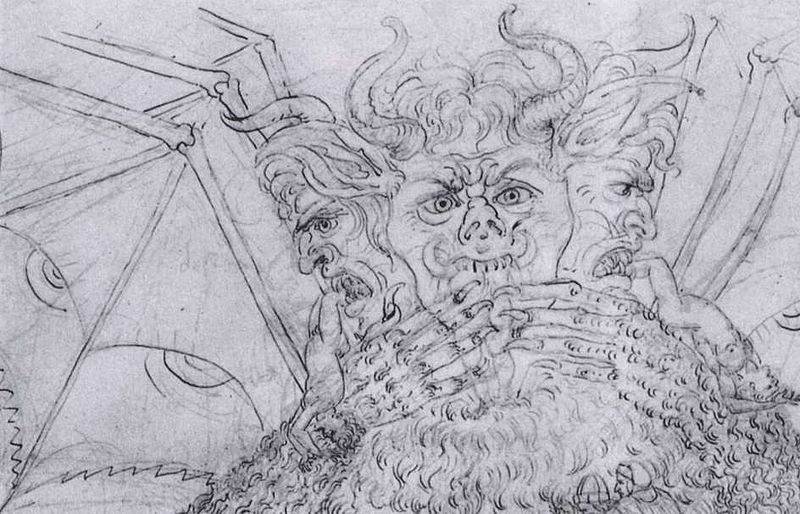 The Courtauld is presently exhibiting thirty of Dante's drawings illustrating scenes from Dante's Divine Comedy. Dante wrote his vision of hell, purgatory and heaven when in exile from Florence, between (approximately) 1308 and 1320. Botticelli's drawings are dated to c.1480-1495, by which time the poem was a national Florentine treasure. It is thought that Botticelli's drawings were made for Lorenzo di Pierfrancesco, who is also thought to have received, variously by gift or direct commission, the same artist's Pallas Athene Training a Centaur, Primavera and Birth of Venus. Fortunate fellow, though as a Medici I suppose you felt entitled to such reminders of your magnificence. In time, the Dante drawings wound up in the collection of the 12th Duke of Hamilton, who was obliged by financial distress to sell them - along with other manuscripts - to a national collection in Berlin in 1882. The Courtauld exhibition brings together drawings and manuscripts, including the sumptuous 'Hamilton Bible', in a show entitled 'Botticelli and Treasures from the Hamilton Collection'.
The Courtauld is presently exhibiting thirty of Dante's drawings illustrating scenes from Dante's Divine Comedy. Dante wrote his vision of hell, purgatory and heaven when in exile from Florence, between (approximately) 1308 and 1320. Botticelli's drawings are dated to c.1480-1495, by which time the poem was a national Florentine treasure. It is thought that Botticelli's drawings were made for Lorenzo di Pierfrancesco, who is also thought to have received, variously by gift or direct commission, the same artist's Pallas Athene Training a Centaur, Primavera and Birth of Venus. Fortunate fellow, though as a Medici I suppose you felt entitled to such reminders of your magnificence. In time, the Dante drawings wound up in the collection of the 12th Duke of Hamilton, who was obliged by financial distress to sell them - along with other manuscripts - to a national collection in Berlin in 1882. The Courtauld exhibition brings together drawings and manuscripts, including the sumptuous 'Hamilton Bible', in a show entitled 'Botticelli and Treasures from the Hamilton Collection'.In the Purgatory drawings, souls take on more individual characteristics. The devils drift away and there is generally more space on the page. We see the proud weighed down by stones (thus they can't stand proud, another attraction of the drawings is that with a bit of help from the label they are easy to read), and the envious with their eyes sewn shut, among whom Dante receives the metaphysical light of revelation from an angel. Punishments are mirror opposites of the sins committed: thus, the slothful in life become whirling, frenzied mobs stampeding around (Purgatory 18), and gluttons are reborn as emaciated figures resisting the temptations of water and the fruit of an upside-down tree. The Divine Comedy reads as a legal compendium, covering all possible cases: even in heaven, we meet those who broke their vows, though through no fault of their own, a strange little lawyerly subclause one feels. As Dante enters Paradise, he is accompanied by Beatrice, and the more realized worlds of Inferno and Purgatorio fade out to leave abstract designs of cosmic spheres through which the happy couple glide. There's a lovely fade-out as we leave them, tiny couples on a cloud, disappearing from mortal view.
It's funny how things overlap. I caught this exhibition in a break from the excellent National Theatre Drama Teachers Conference over the river. On the same evening, we were given tickets to Sarah Kane's Cleansed - an updated Inferno, though here the torments and cruelty are unexplained, not drawn into any comprehensible modern scheme; nor was there anything really to recreate the tension between the delicacy of the drawing and the roughness of the content that we find in Botticelli. From faith in art and God to the modern loss of these, je suppose. And the next day, I was fortunate enough to attend a presentation by 1927 theatre company. Their work seemed in the tradition of the drawings, too: 1927 combine music, actors and animation in productions which look back to silent film and early cartoons. The expressive, opened out bodies, the eyes, and the interaction between animated and real figures of their works (Golem, for example) are pure Botticelli, pure Dante. A replacement bus service from Basingstoke made the journey through various underworlds complete.
No comments:
Post a Comment